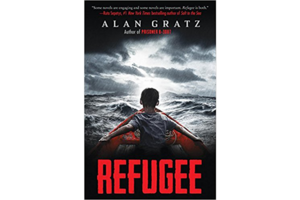How to explain refugee crisis to kids? Books.
Recently a number of children’s books tackling the global refugee crisis have hit the market, helping to humanize the conflict, as well as educate, empower, and build empathy in young readers.

In 'Refugee,' by Alan Gratz, 12-year-old Mahmoud Bishara is forced to flee violence in Aleppo after his home is destroyed.
The news is flooded with stories of war and refugees, and the statistics are staggering. There are now more than 65 million refugees, asylum seekers, and internally displaced people around the world, according to the United Nations High Commissioner for Refugees.
More than half of the world’s refugees in 2015 were children, a fact that many children and teens have met head-on in the news and in their neighborhoods and schools. Rife with violence, suffering, and politics, it’s a subject most parents struggle to explain to kids. But as with some of the most difficult topics in life, books are providing answers.
Recently a number of children’s books tackling the global refugee crisis have hit the market, helping to humanize the conflict, as well as educate, empower, and build empathy in young readers.
The books range from picture books for kids as young as four chronicling how war-torn children finds solace in painting and taming wild birds, to mid-grade reads about the long journeys and difficult assimilation refugee kids face, to young adult novels for teens tackling the toughest subjects – war, violence, trauma.
The books don’t only convey the hardship that refugees face – they also capture the triumphs and resilience of children who are refugees, noted Colorin Colorado, a bilingual site for parents and educators.
“Stories can facilitate dialogue and promote healthy communication on this difficult topic, help to foster empathy and understanding, and even inspire young readers to take action to ensure safe and welcoming environments in their own communities,” the youth book site Brightly recently wrote.
Some help humanize the conflict and build empathy for the challenges refugees face. In “Refugee,” by Alan Gratz, 12-year-old Mahmoud Bishara is forced to flee violence in Aleppo after his home is destroyed. He and his family embark on a dangerous journey through Turkey and across the Mediterranean to Europe, dealing with smugglers and militants along the way.
“I wanted to make individual refugees visible and turn statistics into names and faces that kids could relate to,” Mr. Gratz told The New York Times.
Other books center on the discrimination some asylum seekers face. In “The Lines we Cross,” a young adult novel by Randa Abdel-Fattah, a teenage Muslim refugee named Mina from Afghanistan faces harassment by Islamophobes and nationalists after her family settles in Australia.
“In a political environment where there’s such a demonization of refugees, I wanted readers to understand what their lives are like,” Ms. Abdel-Fattah, who lives in Sydney, told the Times.
And some simply capture the beauty and grace children find in the most challenging of circumstances. In the picture book “My Beautiful Birds,” by Suzanne Del Rizzo, Sami, a pigeon-trainer must leave his birds behind when his family is forced to flee its home in Syria. At a refugee camp in Jordan, however, he again finds solace in caring for wild birds.
Ms. Del Rizzo based her book on a true story she read about in an article about a Syrian boy living in Jordan in the Zaatari refugee camp, where he tamed wild birds.
While the books described above chronicle recent crises, there are also a number of books about past and ongoing crises.
In “How I learned Geography,” author Uri Shulevitz, writes about a refugee from Warsaw who flees to Turkestan.
“Journey Home,” by Lawrence McKay Jr., is about a little girl named Mai who visits Vietnam with her mother, a Vietnamese refugee who is searching for her birth parents. The books explores how becoming a refugee can impact lives for generations.
And in “Colour of Home,” by Mary Hoffman, a Somali boy who has come to the United to flee the war in Somalia is terribly homesick for Africa until he finds solace and expression for his emotions through painting.
The common thread: these books help children see outside the world they’re living in, providing a lens into the challenges and triumphs of children around the world.
For more children’s stories on refugees, check out this list from the UNHCR.

